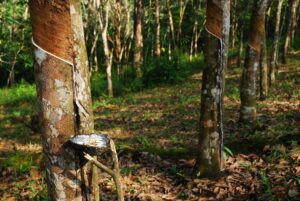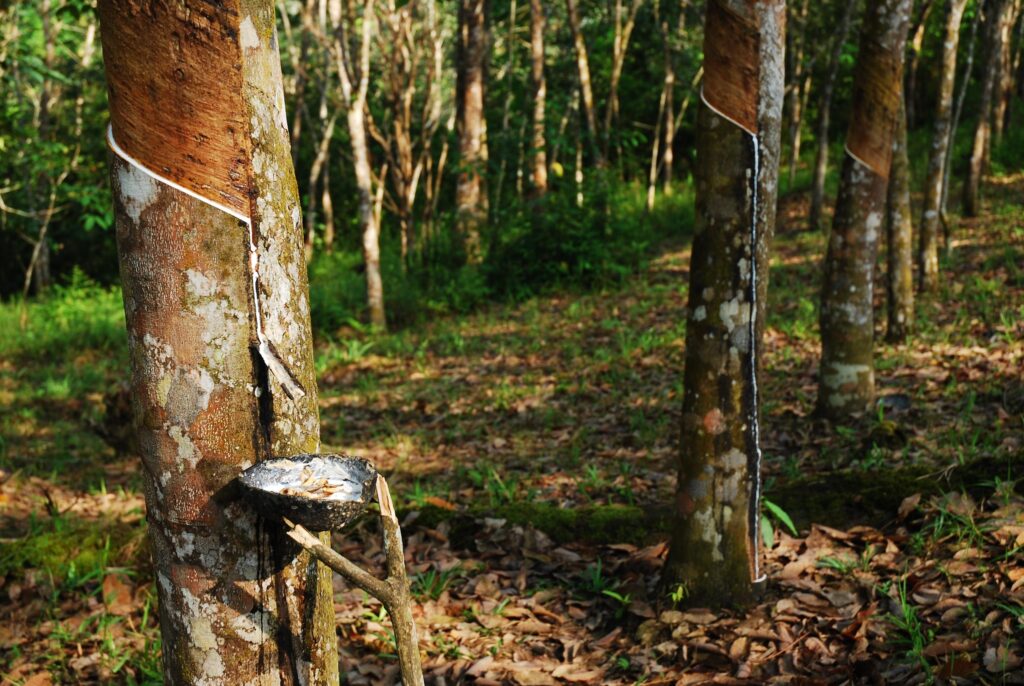Physical Address
23,24,25 & 26, 2nd Floor, Software Technology Park India, Opp: Garware Stadium,MIDC, Chikalthana, Aurangabad, Maharashtra – 431001 India
Physical Address
23,24,25 & 26, 2nd Floor, Software Technology Park India, Opp: Garware Stadium,MIDC, Chikalthana, Aurangabad, Maharashtra – 431001 India


Harvesting latex from rubber trees in a tropical plantation. The process involves carefully tapping the tree bark to collect the milky liquid, which is then processed into various rubber products. Photo by Ryan Woo/CIFOR
By G. R. Diwyanjalee
The rubber tree, or Hevea brasiliensis, is a tropical South American tree belonging to the Euphorbiaceae spurge family. Grown on plantations in tropical and subtropical regions, particularly in Southeast Asia and Western Africa. See more
It features a lot of bark, tall, branching branches, and soft wood. About thirty percent of the milky liquid (latex) that seeps from tree bark wounds is rubber. This rubber can be coagulated and processed into solid items like tires. Concentrated latex can also be used to make dipped products, including surgical gloves. Read more
The first rubber was planted in Sri Lanka in 1876, when 1,919 rubber plants were planted at the Henarathgoda Botanical Gardens in Gampaha.
Vulnerability to Climate Change
Rubber cultivation is sensitive to climatic conditions. Optimal growth occurs in areas with mean annual temperatures of 25°C–28°C and rainfall above 1,500 mm. Climate change can make traditional rubber-growing areas less suitable due to increased droughts, excessive precipitation, or temperature changes, while potentially making some marginal areas more suitable.
Optimal latex production requires high air moisture, while excessive rain can hinder harvesting. Acidic, well-drained soils are essential to avoid waterlogging and root diseases.
Climate change is expected to alter the suitability of traditional rubber-growing areas, with drought and excessive precipitation rendering some areas less favorable and making marginal areas more viable.
The traditional rubber-growing regions of Kerala state in India have been experiencing impacts of climate change like floods, landslides, droughts, and cyclones due to extreme weather events since 2016, which adversely affected the rubber plantations and latex production. Read more
In managing the climate issue, assessing the vulnerability is considered a necessity in order to prevent further damage and yield loss of rubber in Malaysia. Read More
Further, Mr. Sankalpa, Senior Research Officer at the Rubber Research Institute of Sri Lanka, said that, though there is not a significant variation in the amount of rainfall in the southwest part of the country, there is a significant variation in rainfall distribution and,which leads to reduced production of rubber in Kaluthara, Kegalle, and Rathnapura. Moreover, there is a huge challenge to keeping the rubber population alive in the eastern part of the country due to drought, as the results are that 20%–25% of plants die at the beginning.
The expansion of rubber plantations in regions like Xishuangbanna, southwest China, has led to significant changes in local hydrology. Climate change and rubber plantation expansion have increased reference evapotranspiration (ET0), driven by decreased relative humidity and increased sunshine duration. Read More
Therefore, the expansion of rubber plantations can increase evapotranspiration rates, potentially leading to local water resource depletion. This is particularly concerning in regions with limited water availability or where rubber plantations are expanding into higher altitudes with different climatic conditions.
Mitigating Climate Change through Rubber Cultivation
However, Rubber cultivation can contribute to climate change mitigation in several ways, although it also faces challenges and limitations.
Despite a reduction in global forest loss rates, deforestation continues at an unsustainable pace, particularly in tropical and sub-tropical regions. Brazil’s environment minister, Marina Silva, emphasizes the importance of sustainable development and forest conservation. Her efforts in the Amazon rainforest have led to significant reductions in deforestation and highlight the potential of rubber plantations to provide sustainable employment and contribute to climate change mitigation. Read more
Government Initiatives for Sustainable Rubber Cultivation in Sri Lanka
Sri Lankan government aims to enhance the environmental benefits of rubber plantations while supporting the livelihoods of rubber farmers. These initiatives contribute to carbon sequestration, soil conservation, and overall climate resilience.
Rubber Development Department (RDD) has been actively promoting sustainable rubber cultivation practices, including the use of high-yielding and disease-resistant rubber clones that require fewer inputs and produce higher biomass for carbon sequestration.
Rubber Research Institute of Sri Lanka (RRISL) has been leading research on developing climate-resilient rubber varieties that can better withstand extreme weather conditions, thereby ensuring sustainable production. They are also investigating improved cultivation techniques that enhance productivity while minimizing environmental impacts.
Rubber Replanting Subsidy Scheme: The government provides subsidies to smallholder farmers for replanting rubber trees. This scheme encourages the replacement of old, low-yielding rubber trees with new, high-yielding varieties, thereby increasing carbon sequestration potential and enhancing sustainability.
Projects like the “Community-Based Rubber Agroforestry System” are being promoted, where rubber trees are planted alongside other crops and trees. This enhances biodiversity, improves soil health, and increases carbon sequestration.
Benefits of Rubber Agroforestry
Rubber agroforestry systems enhance carbon sequestration, nutrient cycling, and soil rebuilding. By retaining more soil moisture and improving water use efficiency, these systems support microbial activity and soil health. The integration of diverse plant species in agroforestry systems increases ecosystem resilience and provides higher economic and ecological incentives compared to monoculture rubber plantations.
The government has launched reforestation and afforestation projects using rubber trees in degraded areas. These projects aim to restore forest cover, enhance carbon sequestration, and provide economic benefits to local communities. For example, rubber plantations in the Moneragala District are part of such efforts. Read more
Sri Lanka has collaborated with international organizations like the Food and Agriculture Organization (FAO) and the International Fund for Agricultural Development (IFAD) to promote sustainable rubber cultivation. These collaborations often include funding, technical assistance, and knowledge exchange on best practices for climate change mitigation.
In conclusion, rubber cultivation plays a significant role in climate change mitigation through carbon sequestration, soil improvement, and land rehabilitation. However, it also faces challenges due to changing climatic conditions. Sustainable practices, government initiatives, and international collaborations are essential to enhance the resilience and environmental benefits of rubber plantations. By integrating these approaches, rubber cultivation can contribute to a sustainable and climate-resilient future while supporting the livelihoods of farmers and local communities.
Comments are closed.
Nice post. I be taught something more challenging on different blogs everyday. It will at all times be stimulating to read content from other writers and follow slightly something from their store. I’d choose to use some with the content material on my blog whether or not you don’t mind. Natually I’ll give you a link in your web blog. Thanks for sharing.
This website online can be a stroll-via for all of the data you wanted about this and didn’t know who to ask. Glimpse here, and you’ll undoubtedly discover it.
Hey there! This post could not be written any better! Reading through this post reminds me of my old room mate! He always kept chatting about this. I will forward this page to him. Fairly certain he will have a good read. Many thanks for sharing!